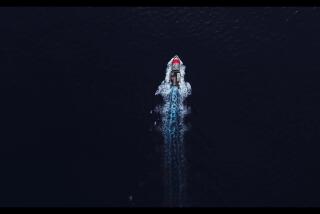Earhart’s Fate Still Prompts Flights of Fancy--or Fantasy
- Share via
HONOLULU — Elgen Long believes Amelia Earhart remains in her plane on the Pacific Ocean floor after running out of fuel.
Ric Gillespie thinks she landed on an island and died a castaway.
Tod Swindell theorizes that she survived a crash landing in the Marshall Islands, was captured by the Japanese and secretly repatriated, living out her life as a New Jersey homemaker.
Sixty-five years after her disappearance at age 39, Earhart remains one of the U.S.’ great mysteries and the subject of continuing searches of the Pacific and research and debate.
The tomboy who became an icon with her short tousled hair, leather jacket and silk scarf already had set numerous flying records when she began her final flight May 20, 1937, from Oakland.
She made it as far as New Guinea. And on July 2, she took off from there for tiny Howland Island on a 2,556-mile flight that would be one of her longest and most dangerous.
Earhart and her navigator, Fred Noonan, never made it to the tiny atoll southwest of Hawaii. She radioed that she was running low on fuel.
The Navy searched for Earhart’s plane but found no trace.
The official position of the U.S. government has been that Earhart and Noonan went down with their plane.
Long, a consultant for Nauticos, a company based in Hanover, Md., supports the government conclusion and this year led a $1.7-million, 27-day search of waters within 100 miles of Howland. The expedition had equipment problems and ended early. Nauticos plans to resume the effort when repairs are made and more money is raised, Long said.
“We have high expectations the airplane is in the area we are searching,” Long said. “It’s important to find it to correct the history of the event. It’s too late to save Amelia, but it’s not too late to save the integrity of her legacy.”
The Nauticos effort was preceded by Dana Timmer’s group in 1999. Head of Howland Landing Ltd. of Reno, he spent $1 million hunting for the plane. Timmer wants to try again, but he’s waiting to raise more money.
He has acquired rights to the lost Lockheed Electra from Earhart’s estate. He wants to restore it and display it at a museum.
Ric Gillespie, on the other hand, believes the plane landed at Gardner Island, now called Nikumaroro, in the Phoenix Islands.
Gillespie, a former aviation accident investigator, heads up the International Group for Historic Aircraft Recovery, a nonprofit effort that has made six trips to Gardner Island over the last 14 years.
On the trip in September, the group found evidence of a castaway. Artifacts recovered there are still being analyzed, Gillespie said.
Other researchers believe the Marshall Islands are where Earhart and Noonan landed; some of the most intriguing theories stem from that site.
Earhart’s mother, Amy Otis Earhart, in a 1949 newspaper interview, said she was convinced that her daughter was on a government mission and was picked up by a Japanese fishing boat and taken to the Marshalls, which the Japanese controlled at the time.
In his 1966 book “In Search of Amelia Earhart,” the late Fred Goerner says former Pacific Fleet commander Chester Nimitz told him Earhart and Noonan were picked up by the Japanese.
Most who believe that theory think Noonan was executed and Earhart either was executed or died of dysentery.
However, Joe Gervais’ research has convinced him that Earhart survived and was secretly repatriated. He believes she lived in New Jersey using the name Irene Craigmile Bolam.
Gervais, a retired fighter pilot, was introduced to Bolam in 1965 at a gathering of the Early Birds of Aviation, a group of aviation pioneers. He thought she resembled Earhart, and she was wearing two aviation pins Earhart had worn.
When a book based on Gervais’ research came out in 1970 -- “Amelia Earhart Lives” by Joe Klaas--Bolam sued. Five years later, the defendants offered to settle for the requested $2 million if Bolam provided fingerprints in front of a judge. Bolam dropped the suit, Gervais said in a 1996 interview with screenwriter Tod Swindell.
Before Bolam died on July 7, 1982, she willed her body to Rutgers University for research. A spokeswoman for the medical school there said the body was cremated. Bolam’s death certificate listed her parents as “unknown.”
Swindell expanded on Gervais’ research, trying to find out if Bolam really was Earhart. He recently showed a conference of Earhart aficionados overlays of photos of the pilot’s face and hands, which matched perfectly with those of Bolam.
“It’s an exact congruence,” said Swindell, who had the help of two forensic pathologists.
Even some skeptics find the evidence intriguing.
“We were inclined to think Irene probably was not Amelia Earhart,” said John Bolam, a retired aerospace engineer from Merritt Island, Fla., and a half brother of Irene Bolam’s husband, Guy. However, he said, “The forensic studies are very convincing.”
Although Bolam denied being Earhart, she was not an ordinary homemaker as she claimed, John Bolam said.
“She was influential, knew many well-placed people and was well traveled.”
More to Read
Sign up for Essential California
The most important California stories and recommendations in your inbox every morning.
You may occasionally receive promotional content from the Los Angeles Times.













